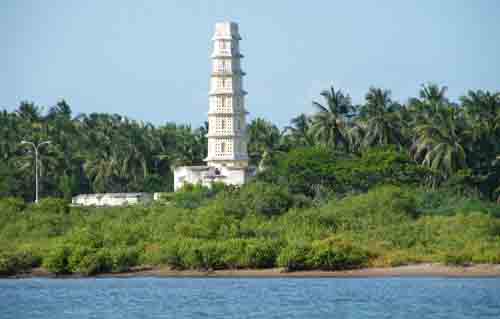Manora Fort

Information on Manora Fort (Thanjavur, Tamil Nadu) - History & Architecture
Manora Fort is located in a coastal village named Sarabendraraja Pattinam over looking the Bay of Bengal in the Thanjavur district in the state of Tamil Nadu in Southern India. It is one of the ancient Forts of India and particularly South India. The architectural style of this fort is Dravidian architecture which is really unique in all aspects. It is situated just 40 mi or 65 km away from the city of Thanjavur. This fort was built in a successful manner by Maratha ruler named Serfoji II in between 1814-1815 in order to commemorate the proud successful advance of the British force over Napoleon Bonaparte.
Manora Fort Architecture
The hexagonal tower within the Manora fort is 8-storied building structure that is nearly 23-meters high just overlooking the vast Bay of Bengal from the immediate shore. The tower is largely surrounded by a strong wall and a perfect moat that resembles like a fort. This particulare monument perfectly looks like a north Indian pagoda, with circular staircase, arched windows and eaves that are separating one storey from the another storey. This fort largely derives its special name "Manora", from the English word "Minaret".
The Fort walls are normal height in all sides. The Fort premises house few common rooms that were used for stationing troops. The rooms had good ventilations with large windows and doors. The Fort had good water supply system from the nearest ponds. The costal surrounding at one side of the fort adds more beauty to this entire structure. This fort is build as per the Dravidian architectural styles and pattern without shades of British, French or Islamic architectural.
Manora Fort History
The Manora fort was built successfully by Maratha ruler named Serfoji II during the period of 1814-1815 in order to grandly commemorate the advance of the British troops over Napoleon Bonaparte during the period from 15 August 1769 to 5 May 1821 in the significant Battle of Waterloo in 1815. This Fort has a light house. It also housed a palatial residential building for the royal family.
In 2000, the restoration and conservation of these monuments were started and completed successfully in 2003. Domestic and foreign tourists were permitted access up to the second phase of the fort. In 2005, a larger portion of the fort was badly damaged during the Indian Ocean Tsunami that hit the Bay of Bengal. The Tamil Nadu state Tourism Development Corporation immediately sanctioned 3195000 (US$53,000) for grandly improving the better infrastructure in and around the fort. This particular project aimed at developing children's park, additional tourist facilities, install display boards, provide additional lighting, plant saplings along the road sides and laying new road connecting the Sethu Road to the Manora fort. The project also aimed to perfectly modify thatched umbrella roof structures on the vast beach area.
Manora Fort Tourism Importance
The Manora fort is one of the most prominent tourist attractions in the Thanjavur district. It is a bit away from the busy city area that provides calm and cool atmosphere for the visiting domestic and foreign tourists. The beach in front of the fort is a hub for good beach related activities. This fort is known for its Dravidian architectural styles and patterns which is rear in the Indian forts. This fort gives good space for understanding the bygone era of this particular region in the history of south India with a lot of perfection.
- Andaman Nicobar Monuments
- Andhra Pradesh Monuments
- Assam Monuments
- Bihar Monuments
- Chhattisgarh Monuments
- New Delhi Monuments
- Goa Monuments
- Gujarat Monuments
- Haryana Monuments
- Himachal Pradesh Monuments
- Jammu and Kashmir Monuments
- Karnataka Monuments
- Kerala Monuments
- Madhya Pradesh Monuments
- Maharashtra Monuments
- Odisha Monuments
- Punjab Monuments
- Rajasthan Monuments
- Tamil Nadu Monuments
- Telangana Monuments
- Uttar Pradesh Monuments
- West Bengal Monuments